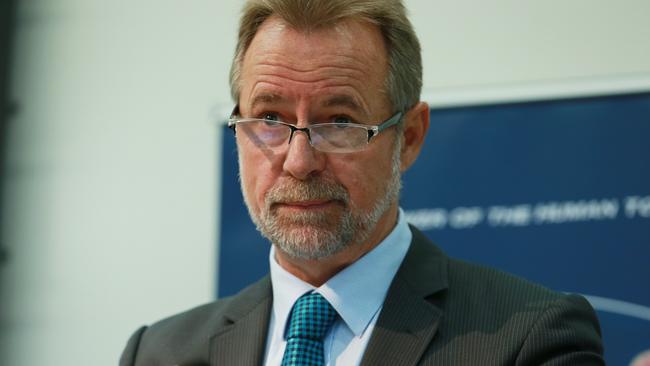‘Close gap’ indigneous funds spent on desk jobs
Hundreds of millions in grants listed under the Indigenous Advancement Strategy funding other public agencies.

Hundreds of millions of dollars in grants listed under the Abbott government’s Indigenous Advancement Strategy are funding other public agencies, including commonwealth authorities, state and territory departments, local councils and even the ABC.
More than half of all grants published in two funding rounds are for amounts of less than $15,000 and for periods of fewer than six months, even though the government has been warned that having many short-term funding agreements can make it difficult for organisations to attract, train and retain indigenous staff.
The Northern Territory is receiving extraordinarily generous federal support on a per-capita basis, more than 40 times the average of all other jurisdictions, from the $4.9 billion four-year IAS funding pot alone.
The Weekend Australian has obtained records of all IAS grants to mid-August, comprising more than 8500 payments to almost 3000 organisations, worth a total of just over $4.1bn.
The data reflects the outcome of what the Abbott government has described as the most significant reorganisation of national indigenous affairs spending in a decade, a top priority immediately after the 2013 federal election, an early step in Tony Abbott’s “new engagement” with Aboriginal people and a precursor to the constitutional referendum push.
The figures are stored behind an interface that makes spending patterns impossible to analyse. When approached for further details, a spokeswoman for Indigenous Affairs Minister Nigel Scullion directed The Weekend Australian to the Department of Prime Minister and Cabinet, a spokesman for which said the department “did not have” an available spreadsheet.
GALLERY: Indigenous Advancement Strategy
The Weekend Australian has since independently obtained and analysed the records. They show that while there have been some improvements, the leviathan network of funds distribution that has presided over decades of failure to close the gap in outcomes for Aborigines and Torres Strait Islanders remains largely intact.
In a speech to the Sydney Institute in March 2013, setting out the Coalition’s approach to indigenous affairs policy, Mr Abbott, the then opposition leader, lamented that “from the very beginnings of British settlement, the health, education, employment and housing standards of Aboriginal people have fallen short of those of other Australians”.
“So, a flurry of activity from a new government lapsing into business-more-or-less-as-usual won’t be good enough,” he said. “A new cycle of enthusiasm-turning-into-cynicism will not do.”
He quoted his “friend”, former Aboriginal affairs minister Fred Chaney, as warning that remote parts of Australia “increasingly resemble a failed state”. Asked for his views this week, Mr Chaney said: “I’m despairing, quite honestly. In a way I think the war is lost, because I think politicians are so f..king stupid. There’s no interest in evidence in this government … This government will regard a successful term as one where they’re re-elected.”
GRAPHIC: Indigenous Advancement Strategy grants
He said many organisations were still hostage to bureaucracy, despite promises the IAS would deliver the opposite, and that government policies were pulling in different directions.
More than $440 million worth of IAS grants, or more than 10 per cent of the total value listed on the DPMC website, is transfer funding for public agencies, including branches of state, territory and local government, and organisations such as the Australian Human Rights Commission, Australian Sports Commission, Bureau of Meteorology, CSIRO and Australian Taxation Office.
Some of the grants support big-ticket education and employment programs. Others pay for bureaucratic posts, communications training, overseas travel and cadetships. The ABC is listed as receiving eight grants worth a total of $212,400, mainly to fund indigenous cadetships at a time when the organisation is engaged in its own diversity push.
The Human Rights Commission is listed as receiving one grant worth $37,400 to pay for “indigenous Australian representation at international indigenous events (United Nations).”
GRAPHIC: Share of money going to government organisations and charities
Shortly after announcing the IAS in last year’s budget, the “most important for decades” for indigenous affairs, Senator Scullion declared the “old ways have not worked”. “Most closing the gap targets are not on track to be met and in remote communities the gap is wider,” Senator Scullion said. “We have to change our approach. More of the money needs to hit the ground if we are to break the cycle of poverty, dysfunction and hopelessness.”
A spokeswoman for Senator Scullion said the minister was travelling yesterday and unable to comment. The Prime Minister’s office did not respond to questions.
Many in the indigenous affairs community have privately complained about lack of information about the distribution of IAS money. Labor’s senator for the Northern Territory, Nova Peris, criticised the lack of transparency around IAS grant size and length of the payments.
“For the IAS to have a meaningful effect, organisations working within it need to be adequately funded, and have certainty about their funding agreements,” Senator Peris said. “Very little can be achieved within six months, very little planning can occur when organisations are unaware of what they’re planning for. To ensure that we are using funding as effectively as possible, we need strong oversight of where money is going and what it’s being used for.”
GRAPHIC: Payments and lengths of grants
The IAS has succeeded in consolidating more than 100 “activities” into five headline programs, but those programs conceal more than 80 “components” that are often overrun with bureaucracy. This is partly because the government has chosen to incorporate more than $2bn worth of existing schemes.
Australian Indigenous Education Foundation head Andrew Penfold, a member of the Prime Minister’s Indigenous Advisory Council, said the Northern Territory appeared to be “double dipping” by spending some indigenous funds improperly with one hand while asking for more with the other. “The whole idea of the Indigenous Advancement Strategy is an absolutely relentless focus on outcomes,” Mr Penfold said. “If the same things are being funded without any better outcomes being achieved then it undermines the whole purpose of the IAS.”
Funding records show more than $1.3bn, or almost a third of the value of all IAS grants to date, are to organisations based in the NT, despite that jurisdiction having just 10 per cent of the nation’s indigenous population. The NT receives more than $19,000 per indigenous resident, or more than double the next largest recipient, Western Australia, where there is spending of roughly $9000 per indigenous resident, government records show. By comparison NSW and Queensland, which each have about 30 per cent of the country’s total indigenous population, are receiving between 10 per cent and 20 per cent of the value of IAS grants, or between $2000 and $4000 per indigenous resident.
On a per-capita basis (including all residents), the NT, which has the country’s highest ratio of indigenous to non-indigenous people at about 30 per cent, is receiving roughly $6000 per person in IAS grants, almost 20 times WA or more than 40 times the average of all jurisdictions besides the NT.
The May budget awarded or retained for the NT an extra $2.4bn in national partnership and Stronger Futures payments over the next eight years. Under the Commonwealth Grants Commission’s horizontal fiscal equalisation principle, the Territory receives more than $5, or roughly 15 times WA’s 30c back per dollar paid into the national GST pool. A quarter of IAS grants to the NT are to organisations in one way or another part of government. The NT government is the fourth-largest governmental IAS grant recipient overall nationwide, with 72 payments worth a total of $31.5m.
GRAPHIC: States and territories
A spokeswoman for Senator Scullion cast doubt over The Weekend Australian’s figures, which derive from government data. “The overwhelming majority of grants through the grant round were for periods of two years or more,” she said. “There were very few (less than 10) grants through the IAS grant round for amounts below $15,000. Generally these were for one-off events.”
In its submission to a Senate inquiry this year, DPMC noted the problems created by organisations having many small grants, quoting the findings of an Australian National Audit Office analysis.





